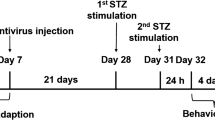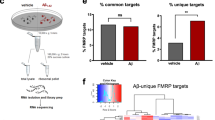Abstract
Contradictory results have been reported on the downregulation and role of the brain-specific protein metallothionein-III (MT-III, GIF) in Alzheimer disease (AD). In this article, the importance of MT-III downregulation in AD brain was re-evaluated in temporal and frontal cortex, hippocampus, and cerebellum of 11 AD patients and two groups of five and six control subjects, respectively. Reverse transcription-polymerase chain reaction (RT-PCR) was used to quantify the levels of MT-III mRNA relative to the levels of three constitutive RNAs: β-actin, glyceraldehyde-3-phosphate dehydrogenase (G3PHD), and ribosomal RNA 18S (rRNA 18S). The distribution of MT-III was similar to that of each of the three constitutive RNAs. The relative levels of each of these RNAs was high in brain regions examined in both AD patients and control subjects. Our findings do not support a downregulation of MT-III mRNA in the frontal cortex as well as the temporal cortex and hippocampus of AD patients. However, the level of MT-III mRNA was not constant in the investigated samples, suggesting that MT-III mRNA regulation could be controlled by factors other than AD pathology. Brain-derived neurotrophic factor (BDNF) mRNA levels were hardly detectable by RT-PCR in human brain tissue; a trend for a decrease was apparent in the temporal cortex of AD patients. In conclusion, the content of MT-III mRNA in the brain of AD patients was not detectably impaired, whereas BDNF mRNA may be affected.
Similar content being viewed by others
Abbreviations
- AD:
-
Alzheimer disease
- AU:
-
arbitrary units
- BDNF:
-
brain-derived neurotrophic factor
- dNTP:
-
deoxynucleotide triphosphate
- EDTA:
-
ethylenediaminetetraacetic acid
- G3PDH:
-
glyceraldehyde-3-phosphate dehydrogenase
- GIF:
-
growth inhibitory factor
- MT-III:
-
metallothionein-III
- OD:
-
optical density
- PCR:
-
polymerase chain reaction
- rRNA 18S:
-
ribosomal RNA 18S
- RT:
-
reverse transcription
- SDS:
-
sodium dodecyl sulfate
References
Allen S. J., Macgowan S. H., Treanor J. J. S., Feeney R., Wilcock G. K., and Dawbarn D. (1991) Normal β-NGF content in Alzheimer's disease cerebral cortex and hippocampus.Neurosci. Lett. 131, 135–139.
Amoureux M-C., Wurch T., and Pauwels P. J. (1995) Modulation of Metallothionein-III mRNA content and growth rate of rat C6-glial cells by transfection with human 5-HT1D receptor genes.Biochem. Biophys. Res. Commun. 214, 639–645.
Appel S. H. (1981) A unifying hypothesis for the cause of amyotrophic lateral sclerosis, Parkinsonism, and Alzheimer disease.Ann. Neurol. 10, 499–505.
Arcari P., Martinelli R., and Salvatore F. (1984) The complete nucleotide sequence of a full length cDNA for human liver glyceraldehyde-3-phosphate dehydrogenase: evidence for multiple mRNA species.Nucleic Acids Res. 12, 9179–9189.
Arriagada P. V., Growdon J. H., Hedley Whyte E. T., and Hyman B. T. (1992) Neurofibrillary tangles but not senile plaques parallel duration and severity of Alzheimer's disease.Neurology 42, 631–639.
Barton A. J. L., Pearson R. C. A., Najlerahim A., and Harrisson P. J. (1993) Pre- and post-mortem influences on brain RNA.J. Neurochem. 61, 1–11.
Braak H. and Braak E. (1994) Pathology of Alzheimer's disease, inNeurodegenerative Diseases (Calne D. B., ed.), W. B. Saunders Company, Philadelphia, pp. 585–613.
Crutcher K. A., Scott S. A., Liang S., Everson W. V., and Weingartner J. (1993) Detection of NGF-like activity in human brain tissue: increased levels in Alzheimer's disease.J. Neurosci. 13, 2540–2550.
Erickson J. C., Sewell A. K., Jensen L. T., Winge D. R., and Palmiter R. D. (1994) Enhanced neurotrophic activity in Alzheimer's disease cortex is not associated with down regulation of metallothionein-III (GIF).Brain Res. 649, 297–304.
Goedert M., Fine A., Hunt S. P., and Ullrich A. (1986) Nerve growth factor mRNA in peripheral and central rat tissues and in the human central nervous system: Lesion effects in the rat brain and levels in Alzheimer's disease.Mol. Brain Res. 1, 85–92.
Goedert M., Fine A., Dawbarn D., Wilcock G. K., and Chao M. V. (1989) Nerve growth factor mRNA distribution in human brain: normal levels in basal forebrain in Alzheimer's disease.Mol. Brain Res. 5, 1–7.
Gomez-Pinilla F., Cummings B. J., and Cotman C. W. (1990) Induction of basic fibroblast growth factor in Alzheimer's disease pathology.NeuroReport 1, 211–214.
Gonzales I. L. and Schmickel R. D. (1986) The human 18S ribosomal RNA gene: evolution and stability.Am. J. Human Genet. 38, 419–427.
Guillemette J. G., Wong L., McLachlan D. R., and Lewis P. N. (1986) Characterization of messenger RNA from the cerebral cortex of control and Alzheimer-affected brain.J. Neurochem. 47, 987–997.
Harrison P. J., Barton A. J. L., Najlerahim A., McDonald B., and Pearson R. C. A. (1991) Regional and neuronal reductions of polyadenylated messenger RNA in Alzheimer's disease.Psychol. Med. 21, 855–866.
Hefti F., Denton T. L., Knusel B., and Lapchak P. A. (1993) Neurotrophic factors: what are they and what are they doing? inNeurotrophic Factors (Loughlin S. E. and Fallon J. H., eds.), Academic, San Diego, CA, pp. 25–49.
Holtzman D. H. and Mobley W. C. (1991) Molecular studies in Alzheimer's disease.Trends Biochem. Sci. 16, 140–144.
Hyman C., Hofer M., Barde Y. A., Juhask M., Yancoupoulos G. D., Squinto S. P., and Lindsay R. M. (1991) BDNF is a neurotrophic factor for dopaminergic neurons of the substantia nigra.Nature 350, 230–232.
Jetté N., Cole M. S., and Fahnestock M. (1994) NGF mRNA is not decreased in frontal cortex from Alzheimer's disease patients.Mol. Brain Res. 25, 242–250.
Knusel B., Winslow J. W., Rosenthal A., Burton L. E., Seid D. P., Nikolics K., and Hefti F. (1991) Promotion of central cholinergic and dopaminergic neuron differentiation by brain-derived neurotrophic factor but not neurotrophin-3.Proc. Natl. Acad. Sci. USA 88, 961–965.
Kobayashi H., Uchida Y., Ihara Y., Nakajima K., Kohsaka S., Miyatake T., and Tsuji S. (1993) Molecular cloning of rat growth inhibitory factor cDNA and the expression in the central nervous system.Mol. Brain Res. 9, 188–194.
Leibrock J., Lottspeich F., Hohn A., Hofer M., Hengerer B., Masiakowski P., Thoenen H., and Barde Y. A. (1989) Molecular cloning and expression of brain-derived neurotrophic factor.Nature 341, 149–152.
Marshak D. R., Pesce S. A., Stanley L. C., and Griffin W. S. (1992) Increased S-100 beta neurotrophic activity in Alzheimer's disease temporal lobe.Neurobiol. Aging 13, 1–7.
Masters B. A., Quaife C. J., Erickson J. C., Froelick G. J., Zambrowics B. P., Brinster R. L., and Palmiter R. D. (1995) Metallothionein-III is expressed in neurons that sequester zinc in synaptic vesicles.J. Neurosci. 14, 5844–5857.
Murase K., Nabeshima T., Robitaille Y., Quirion R., Ogawa M., and Hayashi K. (1993) NGF level is not decreased in the serum, brain-spinal fluid, hippocampus, or parietal cortex of individuals with Alzheimer's disease.Biochem. Biophys. Res. Commun. 193, 198–203.
Murase K., Igasarashi K., and Hayashi K. (1994) Neurotrophin-3 (NT-3) levels in the developing rat nervous system and in human samples.Clin. Chim. Acta 227, 23–36.
Murray K. D., Gall C. M., Jones E. G., and Isackson P. J. (1994) Differential regulation of brain-derived neurotrophic factor and type II calcium/calmodulin-dependent protein kinase messenger RNA expression in Alzheimer's disease.Neuroscience 60, 37–48.
Palmiter R. D., Findley S. D., Whitmore T. E., and Durnam D. M. (1992) MTIII, a brain-specific member of the metallothionein gene family.Proc. Natl. Acad. Sci. USA 89, 6333–6337.
Pauwels P. J., Van Assouw H. P., De Ryck M., Leysen J. E., Dom R., and Van Gool D. (1993) Towards an improved survival of rat brain neurons in culture by cerebrospinal fluid of patients with senile dementia of Alzheimer's type.Brain Res. 610, 8–15.
Phillips H. S., Hains J. M., Armanini M., Laramee G. R., Johnson S. A., and Winslow J. W. (1991) BDNF mRNA is decreased in the hippocampus of individuals with Alzheimer's disease.Neuron 7, 695–702.
Ponte P., Ng S. Y., Engel J., Gunning P., and Kedes L. (1984) Evolutionary conservation in the untranslated regions of actin mRNAs: DNA sequence of a human beta-actin cDNA.Nucleic Acids Res. 12, 1687–1696.
Sheng J. G., Mrak R. E., and Griffin W. S. (1994) S-100 beta protein expression in Alzheimer disease: potential role in the pathogenesis of neuritic plaques.J. Neurosci. Res. 39, 398–404.
Spina M. B., Squinto S. P., Miller J., Lindsay R. M., and Hyman C. (1992) Brain-derived neurotrophic factor protects dopamine neurons against 6-hydroxydopamine and N-methyl-4-phenylpyridium ion toxicity: involvement of the glutathione system.J. Neurochem. 59, 99–106.
Stopa E. G., Gonzales A.-M., Chorsky R., Corona R. J., Alvarez J., Bird E. D., and Baird A. (1990) Basic fibroblast growth factor in Alzheimer's disease.Biochem. Biophys. Res. Commun. 171, 690–696.
Tabaton M., Mandybur T. I., Perry G., Onorato M., Autilio-Gambetti L., and Gambetti P. (1989) The widespread alteration of neurites in Alzheimer's disease may be unrelated to amyloid deposition.Ann. Neurol. 26, 771–778.
Terry R. D., Masliah E., and Hansen L. A. (1994) Structural basis of the cognitive alterations in Alzheimer disease, inAlzheimer Disease (Terry R. D., Katzman R., and Bick K. L., eds.), Raven, New York, pp. 179–196.
Tsuji S., Kobayashi H., Uchida Y., Ihara Y., and Miyatake T. (1992) Molecular cloning of human growth inhibitory factor cDNA and its down-regulation in Alzheimer's disease.EMBO J. 11, 4843–4850.
Uchida Y. (1994) Growth inhibitory factor, metallothionein-like protein and neurodegenerative diseases.Biol. Signals 3, 211–215.
Uchida Y. and Tomonaga M. (1989) Neurotrophic action of Alzheimer's brain extract is due to the loss of inhibitory factors for survival and neurite formation of cerebral cortical neurons.Brain Res. 481, 190–193.
Uchida Y., Ihara Y., and Tomonaga M. (1988) Alzheimer's disease brain extract stimulates the survival of cerebral cortical neurons from neonatal rats.Biochem. Biophys. Res. Commun. 150, 1263–1267.
Uchida Y., Takio K., Titani K., Ihara Y., and Tomonaga M. (1991) The growth inhibitory factor that is deficient in the Alzheimer's disease brain is a 68 amino acid metallothionein-like protein.Neuron 7, 337–347.
Van Eldik L. J. and Griffin W. S. (1994) S-100 beta protein expression in Alzheimer's disease: relation to neuropathology in brain regions.Biochim. Biophys. Acta 1223, 398–403.
Yugushi T., Kohmura E., Yamada K., Sakaki T., Yamashita T., Otsuki H., Wanaka A., Tohyama M., Tsuji S., and Hayakawa T. (1995) Changes in growth inhibitory factor mRNA expression compared with those of c-jun mRNA expression following facial nerve transection.Mol. Brain Res. 28, 181–185.
Author information
Authors and Affiliations
Corresponding author
Rights and permissions
About this article
Cite this article
Amoureux, MC., Van Gool, D., Herrero, MT. et al. Regulation of metallothionein-III (GIF) mRNA in the brain of patients with Alzheimer disease is not impaired. Molecular and Chemical Neuropathology 32, 101–121 (1997). https://doi.org/10.1007/BF02815170
Received:
Revised:
Accepted:
Issue Date:
DOI: https://doi.org/10.1007/BF02815170




